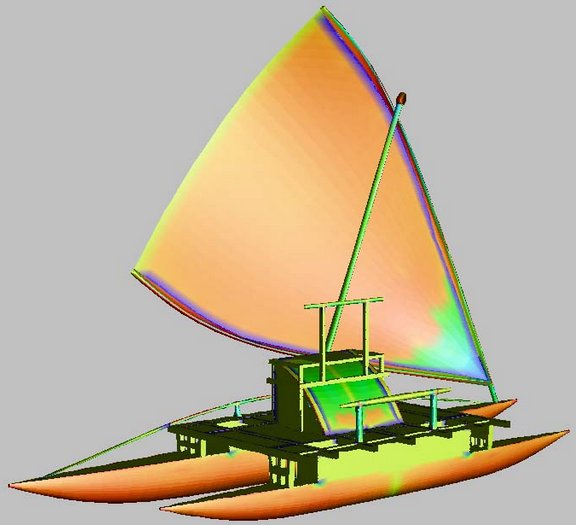Once again. Page 5 of Manuscript E evidently serves as a kind of prelude to the great story of how the dream soul of Hau Maka flew away to discover Easter Island: ... During the time of Ataranga, the people built boats, put them into the water, went on board, and sailed off (across the sea) to find a land where people could (safely) live. During the time of Taana, Taana spoke to his three sons: 'Untie your boat [double-canoe, tokorua vaka], fellows! Sail away and look for the land where the great king can live (safely in the future)!' The boat anchored in front of the three (islets) Motu Nui, Moto Iti, and Motu Kaokao. They had sailed away and had looked for the (new) land, but the boat did not return to its homeland, Maori. ... Based upon the fact that toko in New Zealand also means 'rays of light', it has been suggested that the original props which separated and held apart Sky and Earth were conceived of as shafts of dawn sunlight. Many people perished during the time of Taana. Taana spoke to his assistants (titiro): 'Pick up the keel and lay it down (at the building site) and construct a boat (miro), young men! The boat shall be for the people (mahingo) and also for the king, so that we can all set out and look around to see whether there isn't (somewhere) (the possibility of) escape for the people.' They built the boat during the time of Taana. Thus, everything remained (in its place) until Taana died. Taana passed on his royal power to Matua. Matua established himself (as ruler). They built boats during the time of Hotu ... When returning to page E:5 from page E:53 (a distance measuring 48 pages) we will have aquired a little more insight in how to read. They built boats (plural) during the time of Ataranga - the 6th king on the list - likewise during the time of Hotu (the 10th king).
A single double-canoe (tokorua vaka) was built during the reign of the 8th king Taana. Should we for instance count with 27 days per king ruler, then Taana would be 7 * 27 = 221 days after Oto Uta. And given Oto Uta = Hamal (*30), then Taana could be Aldebaran (*68 = 30 + 221 - 183). Then, 68 + 27 = 95 (Canopus) would correspond to Matua A Taana, the father of the Full Moon king Hotu (St John's Day in Roman times and Te Maro 10 in the time-frame of Bharani).
This was connected with the prophecy of Moe Hiva, the 1st 'master' (ariki maahu) of the 1st king (Oto Uta).
... Moe Hiva was the first prophet (kohou tohu, literally, 'staff of prophecy'); Tuku Maura was the second one; Ngerani, the third one; Po, the fourth one; and Henga, the fifth one. ... Moe Hiva was the master who taught knowledge of the ocean, who knew about the entire width of the ocean, clear up to where it ends (?) - ko moe hiva. te maori i haiteite vai kava te kumi te kumi. o te vai kava. ka peipei rō ... ... The prophecy of Moe Hiva, viz. that Land would sink into the Sea, came true during the rule of Roroi - the 4th ariki motongi: Clearly we can here imagine a reference to that part of the sky dome which was called the Sea: ... This [σ Sagittarii] has been identified with Nunki of the Euphratean Tablet of the Thirty Stars, the Star of the Proclamation of the Sea, this Sea being the quarter occupied by Aquarius, Capricornus, Delphinus, Pisces, and Pisces Australis. It is the same space in the sky that Aratos designated as Water ... And when later the Explorers on their boards repeatedly were washed ashore on the west side of Easter Island this could have alluded to how in ancient times the Sea was changing into Land at 1-iku:
The beginning of the Sea (the end of Land) came during the reign of the 4th king Roroi. ... Interestingly, since another meaning of shi is 'death', the number 4 is considered unlucky ... Fertile Land, on the other hand, was generated by fresh water running down from the mountain tops.
King Roroi should accordingly have come to power 3 * 27 = 81 right ascension days after Hamal, and we can count *30 + *81 = *111. This was where the rising fish of dawn went down - 'showing its buttocks' - coinciding with day 16 after the true heliacal rising of Canopus (*95), when this star would reappear again late at night after its close encounter with the Sun.
|
|||||||||||||||||||||||||||||||||||||||||||||||||||||||||||||||||||||||||||||||||||||||||||||||||||||||||||||||||||||||||||||||||||||||||||||||||||||||||||||||||||||||||||||||||||||||||||||||||||||||||||||||||||||||||||||||||||||||||||||||||||||||||||||||||||||||||||||||||||||||||||||||||||||||||||||||||||||||||||||||||




